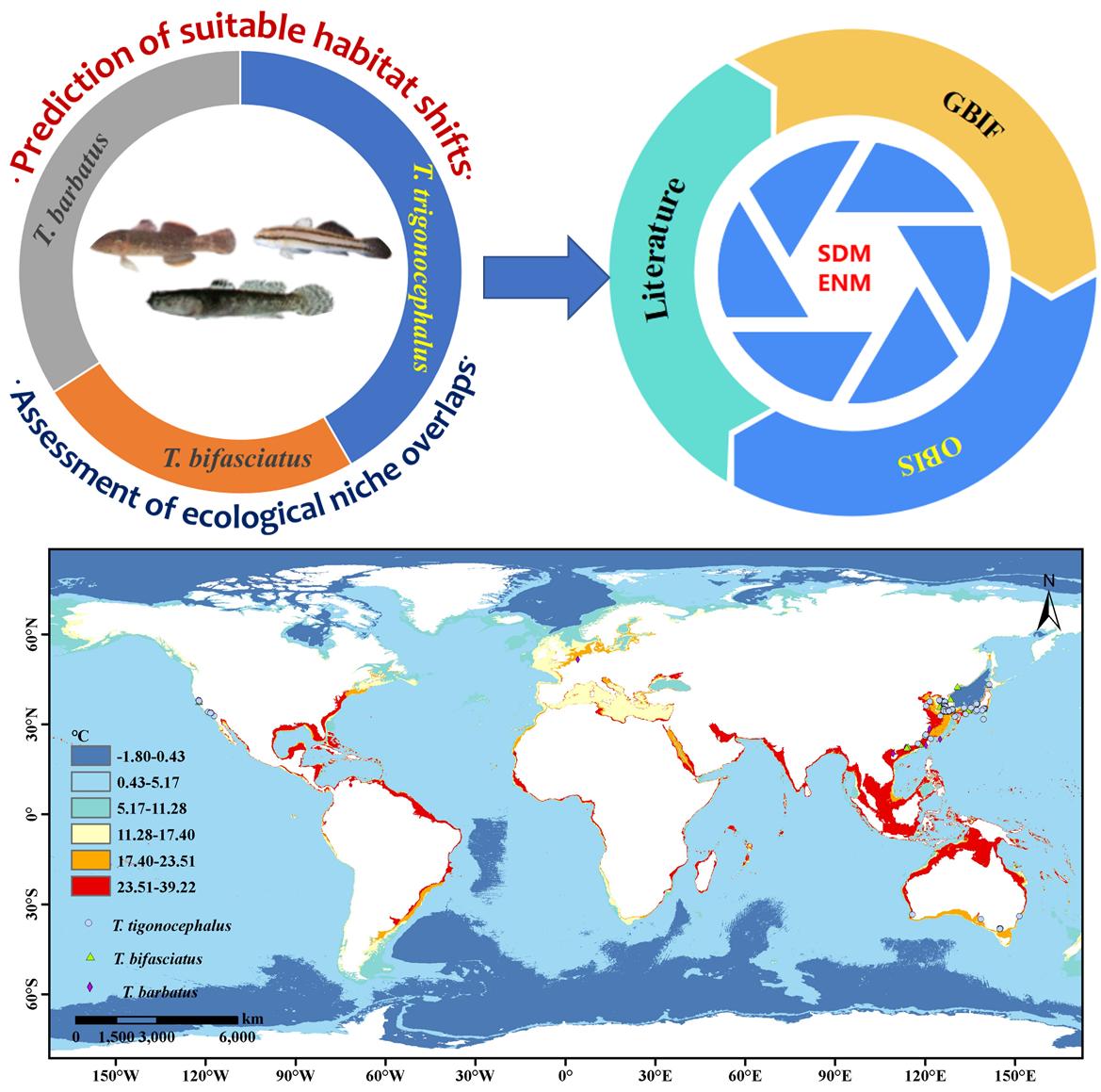The tridentiger typically dwells in semi-saline and freshwater environments located in the tropical, subtropical, and temperate regions of the Western Pacific Ocean. It occupies a crucial position in the food chain, making it ecologically significant.
As an indicator species, the tridentiger is highly vulnerable to environmental changes, and it is likely that global climate change will result in significant alterations or even loss of its habitat. Therefore, it is vital to systematically analyze the response strategies of the tridentiger to global climate change in various habitats.
Recently, the research team led by Prof. LI Jun from the Institute of Oceanology of the Chinese Academy of Sciences (IOCAS) conducted a systematic analysis of the dynamic shift of suitable habitats for three species of tridentiger (Tridentiger trigonocephalus, Tridentiger bifasciatus, Tridentiger barbatus).
The stydy was published in Marine Pollution Bulletin on Nov. 22.
"We used the species distribution model (SDM) and ecological niche assessment model (ENM) to quantify the first-ever overlap of ecological niches between intertidal and subtidal tridentiger," said CHEN Shaohua, first author of the study. Environmental factors such as distance from the shore, primary productivity, and temperature were found to be the primary drivers impacting the distribution of intertidal and subtidal habitats suitable for Tridentiger. These factors contributed to 94% of the distribution of all three species studied. The SDM Maximum Entropy Model (Maxent) identified four hotspots for T. trigonocephalus and T. barbatus globally, in addition to those in the western Pacific Ocean. T. bifascitus and T. barbatus inhabit waters off the coasts of Seattle and California in the eastern Pacific Ocean, off the coasts of New York and New Jersey in the western Atlantic Ocean, off the coasts of Amsterdam and Brussels in the eastern Atlantic Ocean, and off the coasts of Uruguay and Mar del Plata in South America. T. bifascitus has three main habitats located in the western Pacific Ocean, off the coasts of New Jersey and Delaware in the western Atlantic Ocean, and off the coasts of Flensburg and Amsterdam in the eastern Atlantic Ocean. Additionally, another habitat can be found offshore of Uruguay in the southern Atlantic Ocean. It also has a habitat off the northern coast of Uruguay in South America.
"Previous research has been found insufficient in presenting a clear explanation of the tridentiger, a sedentary burrower, under future climate change," said Dr. XIAO Yongshuang, corresponding author of the study. "Based on the results of the current study, it can be concluded that tridentiger in fact underwent a significant local expansion and contraction of its viable habitat, but did not exhibit any poleward migration."
The analysis of ecological niche overlap indicated that T. trigonocephalus and T. barbatus exhibit considerable ecological overlap. Their habitats overlap by 44.7×105km2, accounting for 25.2% and 40% of suitable habitats for the two species, respectively. The study revealed that T. trigonocephalus is able to adapt to both intertidal and subtidal habitats, and has a stronger ability to adapt to future global climate change compared to T. barbatus. It is evident that the T. trigonocephalus displays a high level of resilience to changing environmental conditions. Furthermore, the study confirmed that the T. trigonocephalus can adapt to both intertidal and subtidal habitats, possesses a wider distribution range in its habitat area, and has a stronger adaptive capacity to future global climate change.
"This study offers new insights into how typical intertidal and subtidal fish species respond to global climate change, and also demonstrates varying degrees of ecological overlap among intertidal/subtidal species with particular life history traits," said Prof. LI.
This work was supported by National Natural Science Foundation of China, Key Deployment Project of Center for Ocean Mega-Science, National Key Research and Development Program, Chinese Academy of Sciences, CARs for Marine Fish Culture Industry.

Habitat-driven and ecological niche overlay study design for the Tridentiger
Shaohua Chen, Yongshuang Xiao*, Zhizhong Xiao, Daoyuan Ma, Jun Li*, Angel Herrera-Ulloa. (2023). Prediction of suitable habitat shifts and assessment of ecological niche overlaps for three Tridentiger species with intertidal and subtidal characteristics under future climate changes. Marine Pollution Bulletin. DOI: 10.1016/j.marpolbul.2023.115827.
(Text by XIAO Yongshuang)
Media Contact:
ZHANG Yiyi
Institute of Oceanology
E-mail: zhangyiyi@qdio.ac.cn
(Editor: ZHANG Yiyi)

